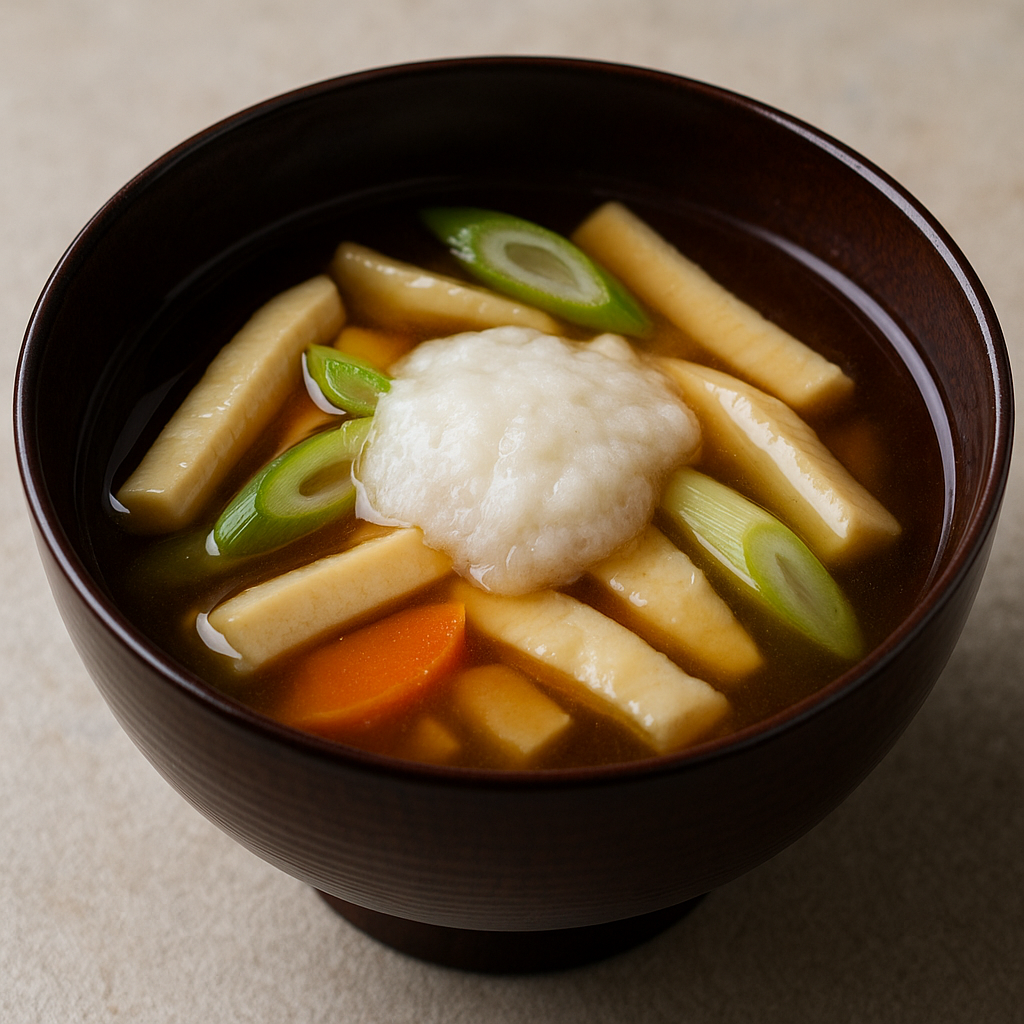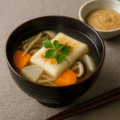ぬっぺい汁(岩手)の特徴
根菜と豆腐・こんにゃくをやさしいとろみで包む、冬のあったか汁です
ぬっぺい汁は、大根・にんじん・ごぼうなどの根菜に、豆腐やこんにゃく、干し椎茸を合わせ、しょうゆ味で整えて片栗粉でとろみをつける岩手の郷土料理です。豆腐が主役の料理であり、具材の旨みが一椀にまとまり、冷めにくく体が温まります。
澄まし×とろみの“やさしい口当たり”が魅力です
昆布やかつお、干し椎茸の戻し汁を生かしただしに、薄いとろみを付けることで、具の食感と香りが引き立ちます。仕上げに柚子皮や生姜を添えると、香りがいっそう冴えます。
ぬっぺい汁(岩手) レシピ
材料(5人分)
- 長芋 … 150g
- にんじん … 120g(半月切り)
- 木綿豆腐 … 3/2丁(細切り)
- 油揚げ … 1枚(油抜き・短冊)
- だし … 1,000ml(昆布+かつお)
- しょうゆ … 大さじ2と1/2〜3
- みりん … 大さじ1〜2
- 酒 … 大さじ1
- 塩 … 少々(味の調整)
- ごま油 … 小さじ1(炒め用)
- 水溶き片栗粉 … 片栗粉 大さじ2+水 大さじ2〜3
- 柚子皮・おろし生姜・長ねぎなど… 適量(仕上げ用)
作り方
- 長芋は皮をむき、すりおろす。
- 大根・にんじんは食べやすく切る。豆腐は細切り、油揚げは短冊切りに。
- 鍋にごま油を敷き、野菜を軽く炒める。だしを注ぎ、沸いたらアクを引く。
- 油揚げを加え、中火で8程加熱し、途中で豆腐を優しく加える。
- 酒・みりん・しょうゆで調味し、数分煮含める。
- 火を弱め、沸いた状態を保ちながら水溶き片栗粉を少しずつ回し入れてとろみをつける。
- 味を見て塩で整える。盛り付けてから最後にとろろをかける。
シェフのワンポイントアドバイス
- 水溶き片栗粉は少量ずつ。沸いている鍋に回し入れて都度混ぜるとダマになりにくいです。
- 調味は酒→みりん→しょうゆの順がなじみやすいです。塩は最後の微調整に。
栄養価(1人分の目安)
- エネルギー … 160〜240 kcal
- たんぱく質 … 7〜12 g(豆腐・油揚げ由来)
- 脂質 … 5〜10 g
- 炭水化物 … 18〜28 g(根菜・片栗粉由来)
- 食物繊維 … 3〜5 g(根菜由来)
歴史
冬の保存野菜を無駄なく使う“とろみ椀”の知恵です
干し椎茸や根菜、油揚げなど手元の材料を合わせ、片栗やくずでとろみをつけて温かさを保つ調理が受け継がれてきました。具だくさんでも消化がよく、寒い季節の定番になりました。
行事や集まりの“大鍋”で親しまれてきました
年越しや集まりの席で大鍋に仕立て、香りづけの柚子や生姜で爽やかさを加える食べ方が根づいています。家庭ごとの具や味加減の違いも受け継がれています。
English Version
Features of Nuppei-jiru (Iwate)
A cozy winter soup that lightly thickens root vegetables and tofu
Nuppei-jiru simmers root vegetables such as daikon and carrot with tofu (often with fried tofu as well) in a soy-seasoned dashi, then finishes with a potato-starch gloss. It is a tofu-forward bowl where flavors come together softly and the gentle thickness keeps the soup warm.
Clear broth + light glaze for a silky mouthfeel
Kombu–katsuobushi (and sometimes dried shiitake soaking liquid) form the base. A subtle thickening elevates texture and aroma; a touch of yuzu zest or ginger at the end brightens the finish.
Nuppei-jiru (Iwate) – Recipe
Ingredients (Serves 5)
- Japanese yam (nagaimo), grated … 150 g
- Carrot … 120 g (half-moon slices)
- Firm tofu … 1.5 blocks (cut into thin strips)
- Abura-age (fried tofu) … 1 piece (parboiled, cut into strips)
- Dashi … 1,000 ml (kombu + katsuobushi)
- Soy sauce … 2½–3 Tbsp
- Mirin … 1–2 Tbsp
- Sake … 1 Tbsp
- Salt … a pinch (to finish)
- Sesame oil … 1 tsp (for sautéing)
- Potato starch slurry … 2 Tbsp starch + 2–3 Tbsp water
- Garnish … yuzu zest, grated ginger, sliced scallion, to taste
Directions
- Peel the nagaimo and grate finely; set aside.
- Cut the carrot into bite-size pieces (add sliced daikon if desired). Cut tofu into thin strips; slice abura-age into short batons.
- Warm sesame oil in a pot and lightly sauté the vegetables. Add dashi; bring to a simmer and skim.
- Add abura-age and simmer about 8 minutes; gently add tofu midway.
- Season with sake, mirin, and soy sauce; simmer a few minutes to meld.
- Maintain a gentle boil and drizzle in the potato starch slurry a little at a time, stirring, to achieve a light glaze.
- Taste and finish with a pinch of salt. Ladle into bowls and spoon the grated nagaimo over the top just before serving.
Chef’s Tips
- Add the slurry gradually to a gently boiling soup, stirring each addition to avoid lumps.
- Season in the order sake → mirin → soy sauce for a rounder finish; use salt only for final tuning.
Nutrition (per serving, approx.)
- Energy … 160–240 kcal
- Protein … 7–12 g (from tofu and abura-age)
- Fat … 5–10 g
- Carbohydrates … 18–28 g (from vegetables & starch)
- Dietary fiber … 3–5 g (from root vegetables)
History
A thrifty “thickened soup” born from winter pantry staples
Households combined on-hand ingredients—dried shiitake, root vegetables, tofu, and abura-age—and used starch (or kudzu) to hold heat and give body. Hearty yet gentle, it became a cold-season standard.
A celebratory big-pot favorite for gatherings
Large pots of nuppei-jiru have long appeared for year’s end and community events, with yuzu and ginger adding fragrance. Family-by-family variations in ingredients and seasoning are part of the tradition.



何でも質問してください!